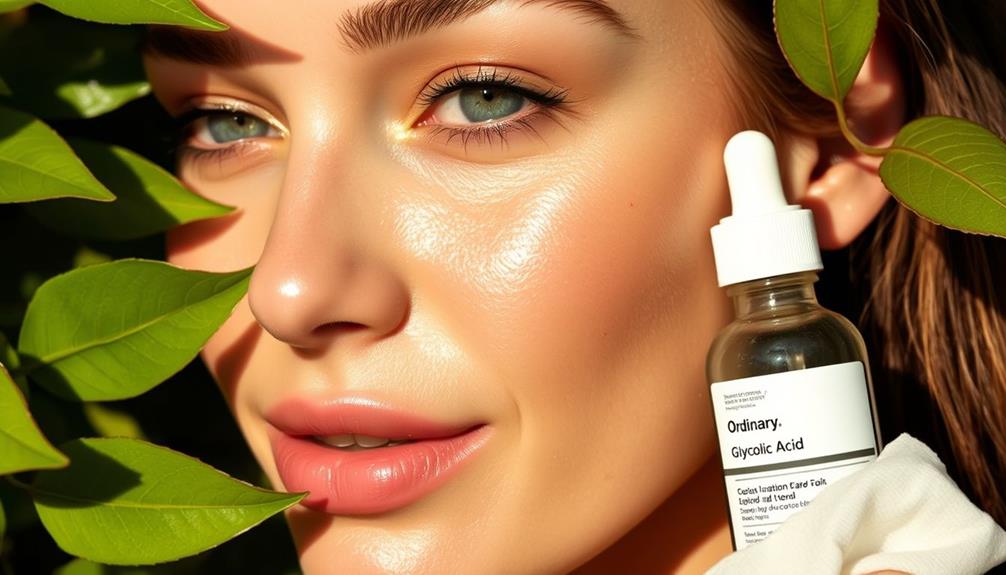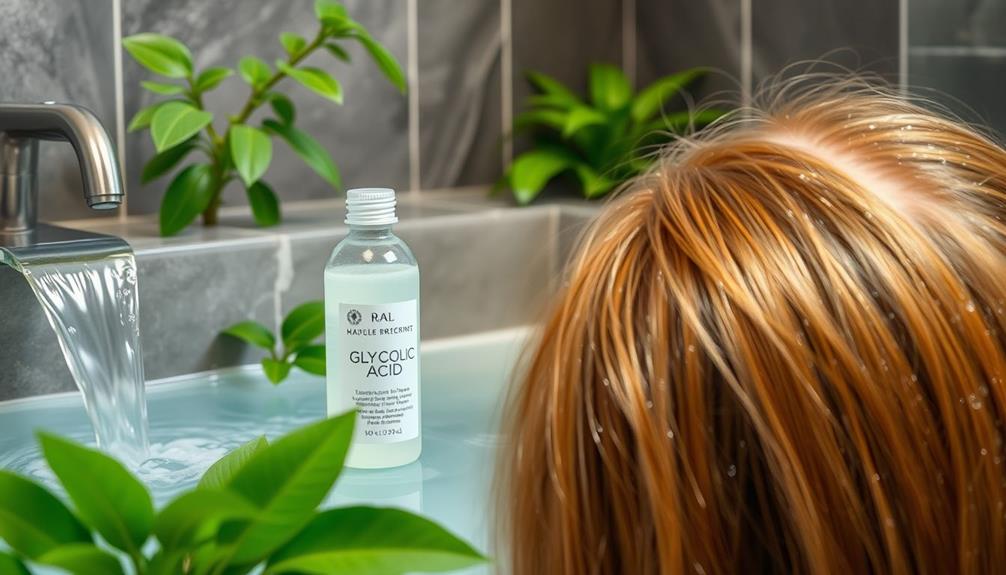The Ordinary Glycolic Acid is a crucial addition to your skincare routine since it softly eliminates dead skin cells, unveiling a more radiant and smoother complexion. This potent alpha hydroxy acid delves deep, aiding in pore minimization and fading hyperpigmentation. As you introduce it into your regimen, you will witness a refined texture and enhanced collagen production, resulting in skin plumpness and diminished fine lines. Remember to start with a lower frequency and monitor your skin’s reaction to prevent irritation. Sunscreen is essential as glycolic acid can heighten UV sensitivity. If you want to explore further on maximizing the benefits of this potent ingredient, there is much more to discover.
Key Takeaways
- Glycolic acid exfoliates dead skin cells, promoting a radiant complexion and improving overall skin texture.
- It minimizes the appearance of pores, helping to prevent breakouts and achieve an even skin tone.
- The acid stimulates collagen production, reducing fine lines and enhancing skin moisture retention for plumpness.
- Glycolic acid effectively targets hyperpigmentation, leading to clearer skin and improved tone.
What Is Glycolic Acid?

Glycolic acid is a powerful exfoliating agent derived from sugar cane that helps renew your skin and brighten your complexion. As an alpha hydroxy acid (AHA), glycolic acid works by effectively penetrating the skin due to its small molecular size. This allows it to dissolve the bonds between dead skin cells, promoting their removal through a process called exfoliation.
Incorporating glycolic acid into your skincare routine can considerably enhance your efforts for clear skin, especially when paired with essential oils for skin health, which offer additional nourishing benefits.
When you incorporate glycolic acid into your skincare routine, you'll notice its ability to target uneven skin tone, textural irregularities, and visible signs of aging like fine lines and wrinkles. By regularly using products containing glycolic acid, you can enhance your skin's overall appearance, as it encourages cell turnover and reveals fresher, smoother skin underneath.
Additionally, glycolic acid has humectant properties, which means it attracts moisture to your skin. This not only aids in hydration but also supports your skin's barrier, making it more resilient.
With consistent application, glycolic acid can be a game changer in your quest for clear skin, facilitating a healthy glow while addressing various skin concerns effectively.
Benefits for Clear Skin
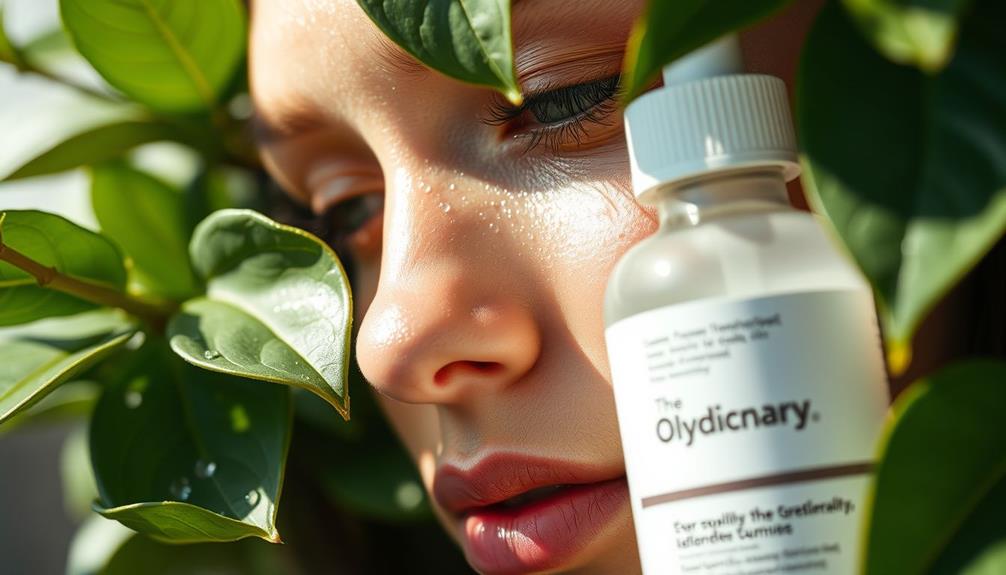
Glycolic acid offers impressive benefits for clear skin, primarily through its exfoliating properties.
By effectively removing dead skin cells, you'll reveal a more radiant complexion and minimize the appearance of pores.
This not only helps prevent breakouts but also promotes an even skin tone over time.
Additionally, incorporating essential oils for skin care can enhance the overall health of your skin, providing additional nourishment and balance.
Exfoliation for Radiance
Exfoliating with glycolic acid can reveal a smoother, more radiant complexion by effectively removing dead skin cells and promoting natural skin renewal. This alpha hydroxy acid (AHA) penetrates deeply, dissolving impurities and enhancing your skin texture. Regular use not only stimulates collagen production but also improves moisture retention, giving your skin a plumper and hydrated appearance.
Here's a quick overview of the benefits of glycolic acid for your skin:
| Benefit | Description | Result |
|---|---|---|
| Exfoliation | Removes dead skin cells | Smoother skin |
| Stimulates Collagen | Boosts collagen production | Reduces fine lines |
| Moisture Retention | Enhances skin barrier hydration | Plumper appearance |
| Targets Uneven Tone | Reduces hyperpigmentation | More uniform complexion |
Incorporating glycolic acid into your skincare routine can help clear up acne and promote an even skin tone over time. Enjoy the radiance that comes from consistent exfoliating, and watch your skin transform!
Pore Minimization Techniques
Minimizing the appearance of pores is vital for achieving clear, smooth skin, and incorporating effective techniques can make a significant difference.
One of the most powerful tools in your skincare arsenal is glycolic acid. This exfoliating agent not only removes dead skin cells but also enhances skin cell turnover, helping to reduce the buildup that can clog pores.
Additionally, maintaining good indoor air quality can support overall skin health by reducing allergens and irritants in your environment, as seen with effective air purification methods.
Here are three techniques to incorporate glycolic acid for ideal pore minimization:
- Regular Exfoliation: Use a glycolic acid product two to three times a week to gently exfoliate and prevent pore blockage. This routine promotes a smoother texture and clearer skin.
- Hydration: After exfoliating, make sure you apply a hydrating moisturizer. This helps maintain skin balance, preventing excess oil production that can lead to enlarged pores.
- Sun Protection: Always apply sunscreen daily. Glycolic acid can increase your skin's sensitivity to sunlight, so protecting your skin from UV damage is vital for maintaining pore size.
How to Use Glycolic Acid
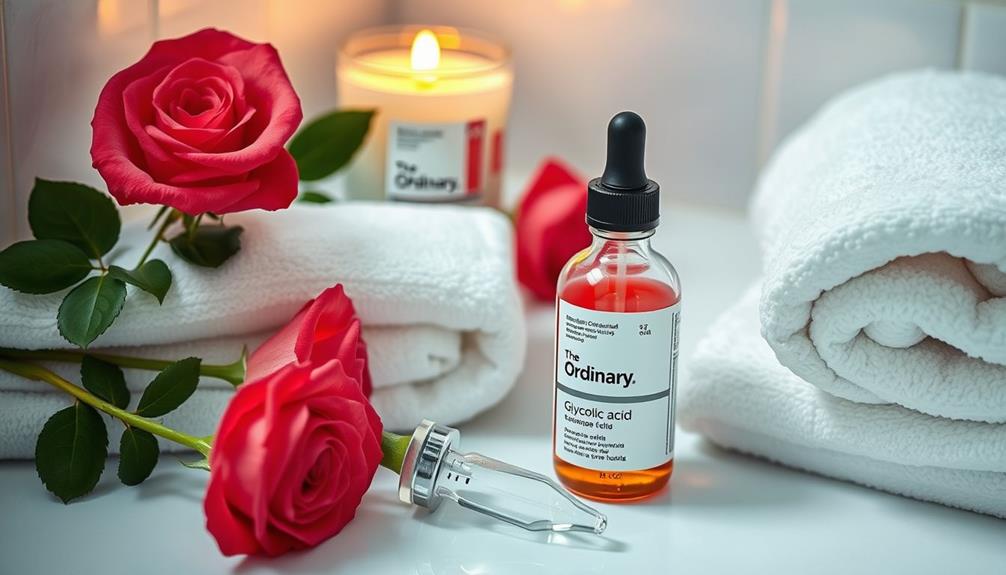
To achieve the best results with glycolic acid, apply a 7% exfoliating toner on dry skin after cleansing, ideally in the evening. This timing helps minimize UV sensitivity and enhances the toner's effectiveness.
Incorporating a calming bedtime routine can also promote better overall skin health, as stress can negatively impact your skin's appearance. Start by using it once a week; gradually increase to twice a week to prevent over-exfoliation and allow your skin to acclimate.
Use a cotton pad or your fingers to evenly distribute the toner across your face and neck, ensuring you avoid the eye contour area. After application, follow up with a hydrating serum or a rich moisturizer to replenish moisture and soothe any potential skin irritation.
Additionally, consider how gentle yoga stretches can enhance relaxation and support your skin's recovery.
Before diving into regular use, always perform a patch test to check for any adverse reactions, especially if you have sensitive skin. This simple step can save you from discomfort down the line.
Understanding the Purging Process
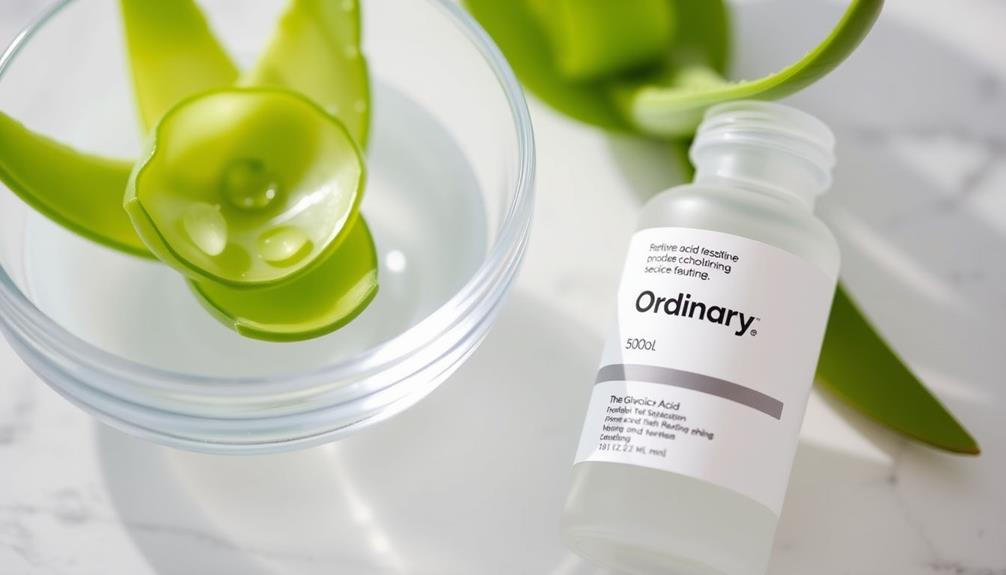
When you start using glycolic acid, your skin may go through a purging process, leading to temporary breakouts as it adjusts to the increased exfoliation. This purging process typically lasts between 2 to 6 weeks, especially if you have acne-prone skin. During this time, you might notice some bumps or mild flaking, which are normal signs that your skin is renewing itself.
It's important to maintain a consistent skincare routine, similar to how effective filtration and pump protection can enhance the performance of your airless sprayer. Here are three key points to remember about the purging process:
- Normal Reaction: Bumps and breakouts indicate that glycolic acid is working and accelerating the shedding of dead skin cells.
- Patience is Key: It's vital to continue using glycolic acid throughout the purging phase. Stopping too soon can hinder your skin's overall improvement.
- Individual Variations: Everyone's skin reacts differently; some may experience more significant breakouts, while others might see little to no change.
Understanding this purging process helps you remain patient and committed to your skincare routine, ultimately leading to clearer and healthier skin. Embrace the journey, as the end results are worth it.
Recommended Products for Use

Several effective products can enhance your skincare routine while using glycolic acid for clearer skin. One standout option is The Ordinary Glycolic Acid 7% Exfoliating Toner, designed specifically to target textural irregularities and dullness. By incorporating this toner, you can achieve a smoother complexion.
Additionally, the principles of self-exploration through body awareness can be applied to your skincare routine, helping you to better understand your skin's needs and reactions.
For even better results, consider using Glycolic Peel Cleansing Pads as recommended products by dermatologists. These pads work to clear pores and enhance skin clarity, making them a great addition to your routine.
After exfoliating, don't forget to soothe your skin with a moisturizer like Dermatologists Choice Hydrating Complex, which helps alleviate any potential irritation and keeps your skin hydrated.
Additionally, try the Facial Enhancement Cream from Dermatologists Choice. This cream complements glycolic acid treatments by improving skin texture and tone.
To maximize the benefits of glycolic acid, start with lower concentration products and gradually increase usage based on how your skin tolerates the treatment. This strategic approach can help you achieve the clear skin you desire while minimizing any adverse effects.
Precautions and Considerations
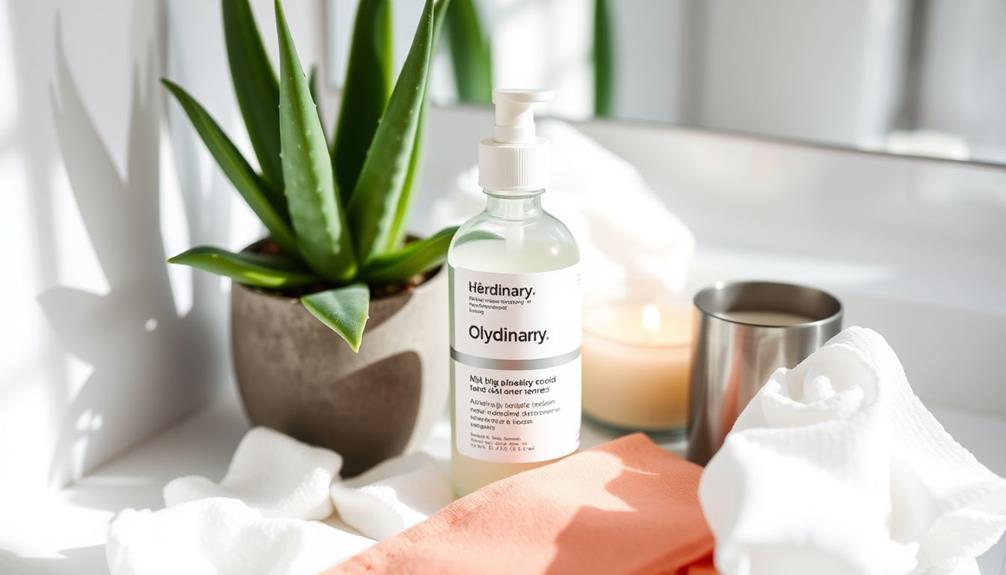
Using glycolic acid can yield impressive results, but it's important to be aware of the precautions and considerations to guarantee your skin remains healthy and irritation-free. Here are three critical points to keep in mind:
- Sun Protection: Glycolic acid can increase skin sensitivity to sunlight. Always apply a broad-spectrum sunscreen during the day to protect your skin from UV damage.
- Skin Condition: If you have sensitive, peeling, or compromised skin, it's best to avoid glycolic acid. Using it in these cases may worsen irritation and lead to adverse reactions.
- Combine with Caution: Avoid using glycolic acid alongside other exfoliating products, like retinoids or Vitamin C. Mixing these can heighten skin sensitivity and increase the risk of irritation.
To minimize discomfort, consider gradually introducing glycolic acid into your routine starting with lower concentrations. If you experience severe irritation, such as persistent redness, itching, or swelling, discontinue use immediately and consult a physician. Always prioritize your skin's health and safety when incorporating new products.
Integrating Into Your Skincare Routine
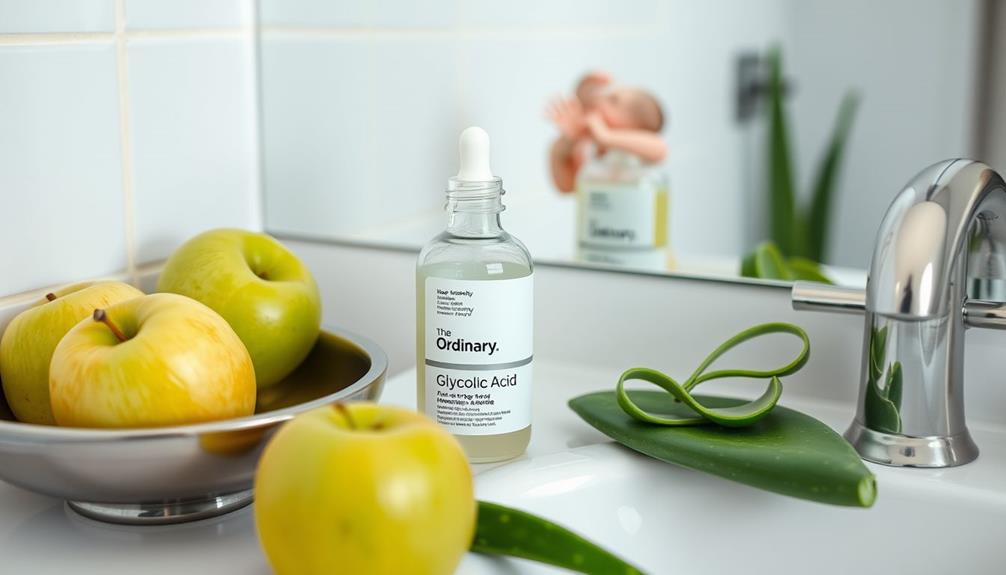
Integrating glycolic acid into your skincare routine can dramatically enhance your complexion, but doing so requires a thoughtful approach to prevent irritation.
Start with The Ordinary Glycolic Acid 7% Exfoliating Toner, applying it to clean, dry skin in the evening. This timing helps minimize UV sensitivity and maximizes exfoliating benefits. Initially, use the toner just once a week, gradually increasing to twice a week as your skin builds tolerance, avoiding over-exfoliation.
After applying glycolic acid, always follow up with a hydrating serum or a rich moisturizer. This step replenishes moisture and soothes your skin, counteracting any potential dryness from exfoliating.
Be cautious not to mix glycolic acid with other exfoliating agents or sensitive products like retinoids or vitamin C, as this can lead to irritation.
Before diving in, conduct a patch test to verify your skin responds well and to confirm compatibility with your skincare routine.
Glycolic Acid in Haircare

Glycolic acid isn't just for your skin; it can really boost your haircare routine too.
It helps hydrate your scalp and creates a better environment for hair growth when used correctly.
Plus, pairing it with complementary products can enhance your overall results, so let's explore how to make the most of it.
Scalp Hydration Benefits
For a rejuvenated scalp, glycolic acid effectively exfoliates dead skin cells and enhances hydration, creating a healthier environment for hair growth. When you incorporate glycolic acid into your haircare routine, you'll notice significant improvements in scalp hydration and overall hair health.
Here are three key benefits of using glycolic acid for your scalp:
- Exfoliation: It removes dead skin cells that can clog hair follicles, promoting a fresher, cleaner scalp.
- Hydration: Glycolic acid helps alleviate dryness and flakiness, providing moisture where it's needed most.
- Improved Circulation: Massaging glycolic acid into your scalp boosts blood circulation, which can stimulate hair growth.
Frequency of Application
Finding the right frequency for applying glycolic acid to your scalp is vital to achieving ideal hydration and health. You can use glycolic acid up to three times per week as a leave-on treatment. This helps rebalance and reduce dryness effectively.
When applying, use a sweeping motion and give your scalp a thorough massage to guarantee even distribution and absorption. The frequency of application is important; overdoing it may irritate your scalp, while too little mightn't provide the benefits you seek.
Regular use of glycolic acid promotes scalp health, leading to improved hair texture and shine over time. This treatment is specifically designed to meet the needs of your hair without unnecessary ingredients that could cause buildup.
To maximize the benefits of your glycolic acid treatments, pay attention to how your scalp responds. Adjusting the frequency according to your individual needs will help you find the perfect balance for best scalp health.
Complementary Haircare Products
Incorporating complementary haircare products can considerably enhance the benefits of glycolic acid, providing your scalp and hair with the nourishment they need. Glycolic acid works wonders for scalp health by rebalancing and alleviating dryness. To maximize its effects, pair it with products specifically designed to support your hair's needs.
Here are three essential types of haircare products to take into account:
- Moisturizing Conditioners: Look for formulas rich in hydrating ingredients to lock in moisture after using glycolic acid, ensuring your hair remains soft and manageable.
- Scalp Treatments: Opt for targeted treatments that focus on scalp rejuvenation, helping to maintain balance and promote overall scalp health.
- Leave-In Treatments: These can provide ongoing hydration and protection, reinforcing the effects of glycolic acid while keeping your hair looking vibrant.
When using glycolic acid, remember to apply it to dry hair and massage it in for ideal absorption. With the right complementary haircare products, you'll not only enhance your scalp's health but also enjoy healthier, lustrous hair.
Future Product Developments

The Ordinary's upcoming body formulations promise to deliver effective skincare solutions inspired by their popular facial treatments. These future products will focus on incorporating effective ingredients that have proven benefits for various skin types.
By leveraging the trusted profiles of their existing formulations, The Ordinary aims to create body care options that complement your overall skincare routine.
With an emphasis on user engagement, The Ordinary encourages feedback from customers to refine and enhance these future products. This approach guarantees that the new body care line meets your needs and expectations.
You'll find that the brand is committed to developing formulations that aren't only effective but also suitable for a diverse range of skin concerns.
To stay informed about these exciting developments, consider subscribing to The Ordinary's updates. By doing so, you'll receive early access notifications about upcoming launches, allowing you to be among the first to experience their innovative body care offerings.
As The Ordinary continues to expand its product line, you can look forward to a more holistic approach to skincare that addresses both facial and body needs with the same level of care and quality.
Frequently Asked Questions
Does Glycolic Acid Help Clear Skin?
Yes, glycolic acid helps clear your skin by exfoliating dead cells, unclogging pores, and promoting collagen production. Regular use can improve texture, reduce acne breakouts, and enhance overall skin clarity, revealing a brighter complexion.
Why Is Glycolic Acid Important for Skin?
Glycolic acid's like a magic wand for your skin! It exfoliates, boosts collagen, and hydrates, leaving you with a luminous complexion. Regular use can transform uneven tone and texture into a smooth, youthful glow.
What Does the Ordinary Glycolic Acid Do for Your Skin?
The Ordinary Glycolic Acid exfoliates your skin, dissolving dead cells and revealing a brighter complexion. It penetrates deeply, targeting uneven tone and texture, while stimulating collagen production for smoother, firmer skin. Regular use boosts clarity and freshness.
What Happens if You Use the Ordinary Glycolic Acid Everyday?
If you use The Ordinary Glycolic Acid every day, you might experience increased skin sensitivity, redness, and irritation. It's best to limit use to once or twice a week to avoid over-exfoliation and protect your skin.
Conclusion
Incorporating glycolic acid into your skincare routine can transform your complexion, giving you the clear skin you've always wanted.
Imagine Sarah, once plagued by stubborn acne, who found renewed confidence after just a few weeks of using a glycolic acid product.
Her journey from insecurity to self-assurance shows the powerful impact this ingredient can have.
So, don't hesitate—embrace glycolic acid and reveal your skin's true potential for a radiant, healthy glow.

